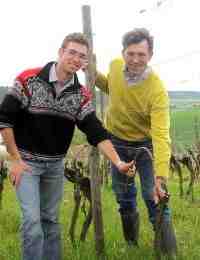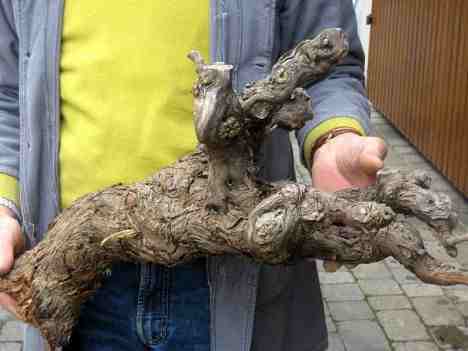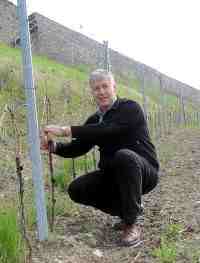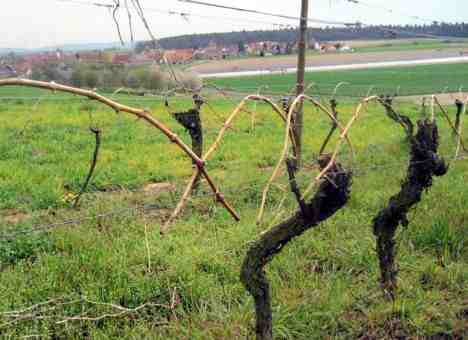In 1835, the Ludwigs-Eisenbahn-Gesellschaft opened the first steam-powered railway line in Germany. The "Adler" locomotive pulled the wagons from Nuremberg to Fürth and back twice a day; horse-drawn carriages were used for further transport. In the same year, Johann Hufnagel planted a small vineyard for his family in Rimbach, Franconia. The small village is located on the famous wine island, only a few kilometres away from the idyllic wine villages of Volkach and Sommerach. The tower of its Catholic parish church of St.Georg, built in 1669, towers over the surrounding hills and forests today as it did then. It seems as if the tower clock strikes in a calmer time beat than that of digital clocks.
 |
| Johannes and Otmar Zang |
For 173 years, the vines have now stood on a remote, windy hill surrounded by fertile farmland. It is the oldest vineyard in Franconia - and holds a small sensation: the vines planted by Hufnagel still bear grapes. Sommerach winemaker Otmar Zang makes wine from them; one that is typically Franconian and yet tastes different. Because in the 19th century, it was not yet common everywhere to cultivate single-variety wine - and so Hufnagel planted more than 25 grape varieties in the "Terroir am Rimbach" at that time, as it can be read in the old church book.
The Hufnagel family farmed the vineyard for five generations until Zang took it over from a descendant in 1990. He decided to continue cultivating the old stock. "It was clear to me that this vineyard is something very special today. In our family there was also such a vineyard with many varieties, but it disappeared over the years," the winemaker reports. With a heavy heart, however, he pulled out half of the old vines. They had been standing only one metre apart from each other since 1835 - too close to achieve good quality. "That was the only way we could get a yield again. They were robbing each other of energy," he explains.
In the past, it was customary to plant individual vines of different varieties next to each other, says estate owner Otmar Zang. This was how the winegrowers ensured yield and quality: "When there was frost in spring, you could harvest the late-ripening varieties, and when the weather was bad in autumn, you at least had the ripened early varieties. So there was always wine, no matter what the weather was like. Zang harvests the grapes by hand and vinifies them together. This wine of different grape varieties, traditionally called "Alter Satz", comes to the customers in Bocksbeutel with the vineyard name "Rimbacher Landsknecht".
 |
| A very old vine |
The tradition of harvesting and fermenting different varieties of a vineyard together is also called "Gemischter Satz" or "Mischsatz" - and is almost extinct in Germany. The term is derived from the planting of different grape varieties in the vineyard. The "Schillerwein" in Baden-Württemberg and Switzerland is produced in this way, as is the genuine Viennese Heurige, which is currently popular again in the bars of the Austrian capital as a fashionable trend wine.
But even Otmar Zang does not know exactly which varieties are grown in the Rimbach vineyard. Experts from the Bavarian State Institute for Viticulture and Horticulture in Veitshöchheim and from the Geilweiler Hof vine breeding station in Siebeldingen in the Palatinate examined the Methuselah vines and identified 25 varieties - ten of which could not be identified. Besides Riesling, Silvaner and the ancient variety Elbling, they found a blue variant of Silvaner as well as the very rare Roter Gutedel. The scientists also attested to the "amazing health" of the Elbling vines, which is "unique in Franconia".
Zang takes a very traditional approach to cultivation. He points to a gnarled vine: "I wait until the Elbling ripens. This is a very late variety; if the grapes of early vines start to rot, we simply cut them out." That's why "no vintage can be compared to the previous one." The 2007 is a voluminous, yet mineral wine with nice acidity and subtle notes of white fruits and herbs. Peppery notes tickle the tongue, the finish is long and discreetly fruity. It goes well with Vesper platters as well as with strong fish, spicy salads and potato dishes.
 |
| Robert Haller% new vineyard manager at Bürgerspital |
Some Franconian winegrowers have rediscovered tradition and yet set modern accents. The Würzburg VDP winery Bürgerspital is processing Riesling, Silvaner and Traminer grapes from one of its best sites in this way, now in its second year. "The Würzburger Abtsleite is very distinctive, actually a great site," enthuses estate director Robert Haller, looking across the valley to the towers of the baroque city. A few years ago, his estate re-cultivated the fallow steep slopes at great expense. But the vines, which were only planted in 2003, were "not yet old enough" for wines in the top segment, Haller explains. So the idea came up to make a traditional "Gemischter Satz" from the yield. The proportion of varieties is roughly equal. With its delicate minerality and diverse aromas of herbs and white fruits, the wine is perfect for eating. "We offered the first Alter Satz in 2006 and could have sold three times the quantity," Haller says happily.
Robert Haller has experience with the age-old method: for many years he managed the Löwenstein winery, which also produces a Gemischter Satz from the Homburger Kallmuth site. "You get the best result if you harvest the grapes in one go and immediately process them together," he reports. "We once harvested and pressed in two courses and brought the wines together later," Haller recalls, "but that didn't work." The secret of the aromatics, he says, lies in the complex transformation and oxidation processes during fermentation. For Robert Haller, the decisive point: "The common terroir of the different grape varieties makes up the special character of the Gemischter Satz". All these factors also distinguish it from the classic cuvée, in which finished wines are composed into a new product.
 |
| The Landsknecht site |
But the land consolidation in the 1970s caused the old-style vineyards to disappear. The new owners usually had no interest in the old vines. In Rimbach, the "Landsknecht" remained in family ownership. Zang's old vines are also still ungrafted. He shovels the earth and grass around a vine aside with his hand. What emerges is a gnarled, thick root with a diameter of over 20 centimetres. "They even survived the phylloxera plague," says Otmar Zang. The dangerous pests came to Europe with the import of Californian vines around 1860. The varieties there are resistant to the aphids - the European ones were not. The phylloxera spread rapidly and destroyed a large part of the vines in all European countries. Viticulture collapsed. The plague passed Rimbach by. But the old plant also survived other catastrophes: in 1985, the arctic cold winter caused the vines to freeze to death. "The following spring, however, the thick, old roots sprouted again," says Otmar Zang.
In 2010, the "Adler" steam locomotive celebrates its 175th anniversary of service - and Otmar Zang will probably pour out his Alter Satz at the big celebration in Nuremberg. "After all, the vineyard and the locomotive are the same age," says the Sommerach vintner happily. But the eagle has long been a museum piece. The Alte Satz is far from it.